People with Disabilities in India: From Commitment to Outcomes
People with Disabilities in India: From Commitment to Outcomes
People with Disabilities in India: From Commitment to Outcomes
Create successful ePaper yourself
Turn your PDF publications into a flip-book with our unique Google optimized e-Paper software.
3.20. The NBCP, like other vertical programs<br />
functions at the apex through a National<br />
Programme Management Cell <strong>in</strong> MoH, State<br />
Ophthalmic Cells, tertiary Regional Institutes of<br />
Ophthalmology and Eye Hospitals, and at the<br />
district level through District Bl<strong>in</strong>dness Control<br />
Society and District/Sub-District Hospitals. In<br />
order <strong>to</strong> address problems of outreach <strong>in</strong> rural<br />
areas, the Programme has tried <strong>to</strong> expand<br />
accessibility of ophthalmic services. It sponsors<br />
central and district mobile units which conduct<br />
mobile eye camps and performance of cataract<br />
surgery. Most cataract operations <strong>in</strong> rural areas are<br />
conducted through mobile camps. Primary health<br />
Table 3.8: Cataract Surgeries under the<br />
National Bl<strong>in</strong>dness Control Programme<br />
Year Cataract<br />
Surgeries<br />
Expenditure<br />
(Rs. <strong>in</strong> crores)<br />
(lakhs)<br />
1985/86- 58.78 28.91<br />
1989/90<br />
1990-91- 83.9 93.27<br />
1994/95<br />
1995-96- 114.52 333.32<br />
1999/00<br />
2000-'01 36.7 109.7<br />
Source: M<strong>in</strong>istry of Health 2005<br />
centers have also been equipped <strong>with</strong> ophthalmic equipment and by post<strong>in</strong>g para medical ophthalmic<br />
assistants. However, by its own admission, the Program’s ma<strong>in</strong> challenges is <strong>to</strong> expand activities<br />
beyond cataract surgeries <strong>to</strong> focus on other causes of bl<strong>in</strong>dness, improve quality of services and<br />
post-surgical follow-up, strengthen human resource development and outreach/public awareness.<br />
3.21. National Leprosy Eradication Programme: Started <strong>in</strong>itially <strong>in</strong> 1954-55 as the National<br />
Leprosy Control Programme, the <strong>in</strong>creased focus led <strong>to</strong> its renam<strong>in</strong>g as the National Leprosy<br />
Eradication Programme (NLEP) <strong>in</strong> 1983 <strong>with</strong> the objective of elim<strong>in</strong>at<strong>in</strong>g leprosy (i.e., reduc<strong>in</strong>g<br />
the caseload <strong>to</strong> less than one case per 10,000 population). In 1993-94, the first National Leprosy<br />
Elim<strong>in</strong>ation Project was started on a national scale, us<strong>in</strong>g multi-drug therapy (MDT),<br />
strengthen<strong>in</strong>g exist<strong>in</strong>g services, <strong>in</strong>tensive health education, tra<strong>in</strong>ed manpower development,<br />
disability prevention and care <strong>in</strong>clud<strong>in</strong>g reconstructive surgery. The second phase of the project<br />
decentralized implementation <strong>to</strong> States/UTs and districts, and <strong>in</strong>tegration <strong>in</strong><strong>to</strong> the overall health<br />
system. Recently there have been nationwide Modified Leprosy Elim<strong>in</strong>ation Campaigns <strong>with</strong><br />
<strong>in</strong>tensified community IEC and better outreach.<br />
3.22. Progress <strong>in</strong> leprosy reduction has been impressive. In 1981, <strong>India</strong> had a prevalence of<br />
57.6 leprosy cases per 10,000 population. As of early 2004, this had fallen <strong>to</strong> 2.44 cases, though<br />
<strong>with</strong> strong statewise concentration <strong>in</strong> UP, Bihar, Maharashtra and West Bengal. Seventeen<br />
States/UTs have elim<strong>in</strong>ated leprosy, <strong>in</strong>clud<strong>in</strong>g large states such as Rajasthan. Another seven<br />
States/UTs are close <strong>to</strong> this goal of leprosy elim<strong>in</strong>ation (<strong>with</strong> current prevalence of 1-2/10000),<br />
<strong>in</strong>clud<strong>in</strong>g MP, Karnataka, Gujarat, AP and Tamil Nadu. As of early 2006, GoI reports that<br />
leprosy has been almost elim<strong>in</strong>ated nationally.<br />
3.23. In other preventive programs however, the authorities have struggled <strong>to</strong> f<strong>in</strong>d effective<br />
modes of <strong>in</strong>tervention. An example is the National Filaria Control Program (NFCP) 60 .<br />
Launched <strong>in</strong> 1955, official reviews revealed very limited impact. The program was then<br />
<strong>with</strong>drawn from rural areas. A revised strategy for control <strong>in</strong> endemic states was launched <strong>in</strong><br />
1996-97. Four ma<strong>in</strong> areas were targeted under the revised strategy: (i) s<strong>in</strong>gle day mass drug<br />
adm<strong>in</strong>istration; (ii) referral services at selected centres; (iii) Information-Education-<br />
Communication (IEC) <strong>in</strong> the community; and (iv) anti vec<strong>to</strong>r measures <strong>in</strong> all urban areas.<br />
3.24. Despite these efforts, only about 11 percent of those liv<strong>in</strong>g <strong>in</strong> endemic areas of <strong>India</strong> fall<br />
<strong>with</strong><strong>in</strong> an active control program, <strong>with</strong> particular shortfall <strong>in</strong> rural areas. The major constra<strong>in</strong>ts of<br />
the program are: (i) detection of carriers by night blood surveys which is costly and poorly<br />
60 <strong>India</strong> is said <strong>to</strong> contribute about 40 percent of the <strong>to</strong>tal global burden of filariasis and account for about<br />
50 percent of those at the risk of <strong>in</strong>fection.<br />
-40-










